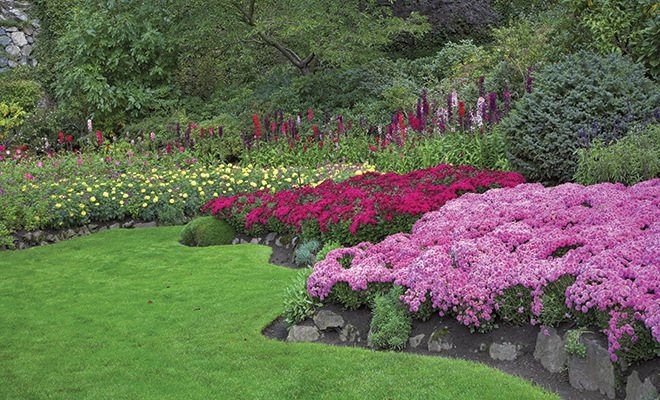
Planting a pest-free garden
The beginning of spring planting season was disappointing at my house. My tulip bed was almost bare, my early daffodils were missing their blooms and I needed to plant new Oriental and Asiatic lilies to replace those that had barely come up last year. Whether the nearly absent winter or common garden pests, both insect and animal, were to blame, was up in the air.
Most gardeners realize that creepy critters can play havoc with their best-laid garden plans. Yet, according to gardener and contributor to the Vegetable Garden blog Greg Holdsworth, there are pesticide-free ways to get rid of insect pests. He writes that there are flowers that have characteristics that naturally deter insects. Decreasing the use of pesticides also draws beneficial insects such as ladybugs and the natural pollinators, the many kinds of bees.
Some of his favorites are the herb borage, which repels certain destructive worms, and chrysanthemums, which can be used to create tea that works as a natural pesticide to repel nematodes and Japanese beetles. Colorful dahlias also repel nematodes, he said, “making them both beautiful and useful in the vegetable garden.”
Popular for their height and big yellow heads are sunflowers, which both encourage beneficial pollinators and deter aphids. Simple and inexpensive petunias are an overall helper that repels asparagus beetles, leafhoppers, aphids and tomato hornworms.
Certain flowers (several sources listed lavender) with a strong fragrance were noted for keeping pests such as fleas, moths and mosquitos out of the garden. In the technique of companion planting, gardeners plant both for what they would like to attract and to keep away. Using this method, certain plants are situated in close proximity because they are mutually beneficial. Borage, with its star-shaped flowers, and clover, a ground cover characterized by small green leaves with pink flowers, can be planted at the perimeter of your garden, creating a barrier that wards off cabbageworms and aphids. Marigolds, with their rich orange and gold blooms, are an inexpensive way to deter pests. The scented variety, such as French marigold, drives away whiteflies from tomatoes and protects the garden’s soil.
Repelling and controlling the mosquito population is of real concern for those who enjoy gardening and spending time outdoors. The Zika virus may not be in your neighborhood today, but the CDC’s predictions are that it will be soon enough. Plants that repel mosquitoes effectively are citronella, lavender, lemon verbena, rosemary, lemon basil, Peruvian basil and lemon-scented geranium. Ageratum, or floss flower, is a low-growing annual with pretty blue, pink or white flowers. It secretes coumarin, which is offensive to mosquitoes and is used as an ingredient in mosquito repellents. Pyrethrum daisy keeps mosquitoes away through compounds known as pyretrins, which act on the mosquitoes’ nervous systems.
As for furry pests such as moles, voles, mice and deer, which are getting more plentiful in populated areas, there are many remedies.
At my house, I never mind the deer eating apples that drop from the trees in September, but you don’t want your gardens ruined by them. The Old Farmer’s Almanac suggests planting the most delectable flowers, such as tulips, in the center of a flower bed and then surrounding the bed with a flower with a strong scent such as lavender. The almanac also noted that rabbits don’t like chrysanthemums, columbines, four o’clocks, foxglove, gladiolas, hollyhocks, impatiens, iris, snapdragons, morning glories, sweet peas and verbena. That’s a pretty extensive list of some of the most popular garden flowers. This should spur me to finally plant some lovely gladiolas, one of my favorite flowers.
The Almanac notes that deer steer clear of chrysanthemums, columbines, foxglove, iris and lavender as well, but also don’t care for begonias, salvia, Shasta daisies, verbena and zinnias.
Have you ever considered “planting” a rock garden? Although it features a judicious amount of plantings, this can be a way to bring the focus to the artful arrangement of multi-size rocks and stones, which obviously are not a tempting target for pests.
Other gardeners recommended physical barriers such green coated chicken wire to surround a raised bed, saying it’s not as much of an eyesore as it sounds, or cracked eggshells and coffee grounds to deter slugs. One gardener on Houzz recommended using pepper and cinnamon, claiming, “It’s been keeping all the critters away. I’ve got some vegetables growing out back. I hear the deer at night. They have not touched them.”
For rabbit control, Better Homes and Gardens recommends some favorites such as veronica, a one- to two-foot flower whose blue, pink and white blooms flower all year, Siberian iris, which blooms later than the more common bearded iris, salvia, daylilies and the luscious peony.
But, Better Homes and Gardens cautions that some of these popular foils do not work all the time. Rabbits, like people, will eat just about anything when they’re hungry enough! HLM
Sources: almanac.com, bhg.com, houzz.com, hubpages.com, organicauthority.com and wikipedia.com.







